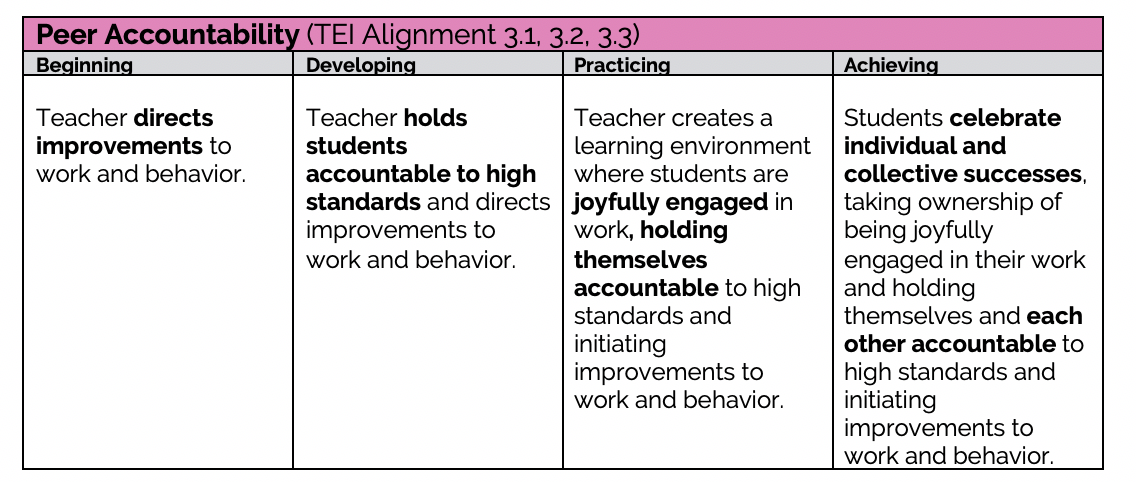Classroom Culture
Phase 2
"Look-Fors" During Observation
Remember: The most helpful part of the observation is not checking off items, but the conversations and reflections that happen after the visit.
Remember: The most helpful part of the observation is not checking off items, but the conversations and reflections that happen after the visit.
|
Beginning/ Developing
|
Practicing/ Achieving
|
Questions to Guide Observation
- Who directs and corrects behavior in the classroom?
- Is there evidence of expected standards of behavior in the classroom? If so, do students know them?
- Is there evidence of expected standards of work (i.e., content-specific expectation) in the classroom? If so, do students know them?
- In group work or other instances of peer collaboration, how do students engage with one another? I.e., how do they provide feedback, correction, etc. to one another?
- Are students compliant or are they joyfully engaged?
Resources
Routines and Procedures
High Expectations for Behavior
Routines and Procedures
- Fast Ways to Keep Kids on Track, tips for empowering students by holding them accountable (Article from TeachHub).
- Responsive Classroom Info Library: This is a treasure trove of resources for building and maintaining a positive classroom culture. You can find excellent resources for organizing the space, routines to build positive and child directed culture, facilitate morning meetings, language to support culture and much more. The link to Classroom Management & Discipline has some great resources aligned to Phase 2.
High Expectations for Behavior
- Group and Cooperative Learning; Students as Classroom Leaders, five essential elements of student-led learning (Article and Video from Harvard University).
- Giving Students a Voice in the Classroom ,classroom strategies to meet students' psychological needs can have self-affirming effects (Article from Educational Leadership ASCD).
- Ready to Learn: Creating a Positive Classroom Culture, lesson on building a safe and inclusive classroom community (Video from Teaching Channel).
- 9 Strategies for Effective Classroom Management, creating a positive classroom culture with strategies and samples (Video examples and written explanation from Teaching Channel).
- Teachers’ Expectations Can Influence How Students Perform, shares ways teachers can change their expectations (Article from NPR).
- Ten Strategies for Creating a Classroom Culture of High Expectations, summary of high expectations of classroom culture (Packet from Southern Regional Education Board, Atlanta, GA).
- Teaching Perseverance: This article shares tips for modeling perseverance and language which supports this work.
- Enjoying each Student: This is one teacher’s perspective on how to get to know each student to better support them and incorporate personal meaning for all individuals.
- Joy in School: This chapter covers what is meant by Joy in School and how to incorporate it in your classroom.
- The benefits of Helping Teens Identify their Purpose in Life: This resource provides insights on how to incorporate individual student values and drive into the classroom to support engagement and motivation.
| Peer Accountability, Coaching Tool | |
| File Size: | 734 kb |
| File Type: | docx |
| Peer Accountability, Coaching Tool | |
| File Size: | 226 kb |
| File Type: | |


